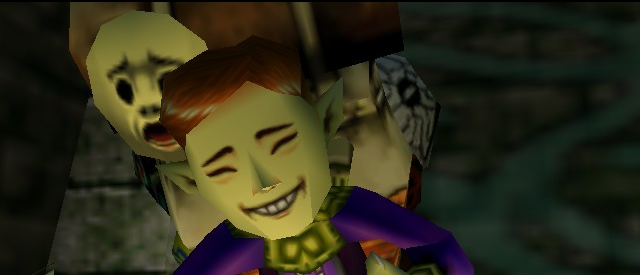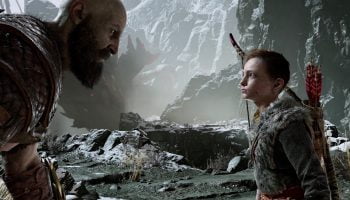Masks are fascinating things. Today, many wear them only for Halloween or for fancy-dress parties. But facial coverings are some of the oldest pieces of technology we have—they have been used in cultures around the world for ceremonies and rituals, as status symbols or funeral objects, for over nine millennia. This is because masks are powerful; they allow the wearer to become someone else within their society—they can symbolically become a manifestation of a goddess or god, an heroic figure, an animal, a clown, or anything else. And more, the act of wearing a mask gives the wearer permission, or even encouragement, to act as someone else. Paradoxically, as Oscar Wilde said in the quote that makes up the title of this article, people often show their truest colours when hidden behind the guise of someone else.
In 2000, Nintendo released The Legend of Zelda: Majora’s Mask for the N64. It was a landmark, and offered a fascinating new perspective on protagonist Link’s world. Majora’s Mask presents a medievalesque world that also draws heavily from the Japanese Noh tradition of masked, stylized classical theatre. Adding elements of the Japanese masked theatre tradition to an otherwise fairly standard fantasy adventure series sets the game apart, and introduces an important new element of cultural hybridity. The masks in the game are influenced strongly both by the Noh tradition and by Western ideas; they provide the possibility of truly exploring the “others” that are so often quickly dispensed with in games. This creates a vibrant game world, although as you might expect, there are some problematic implications—as often happens in explorations of “others” in fantasy worlds.

The Man in the Goron Mask
Throughout the game, Link collects and acquires different masks. The masks are typically awarded upon completion of a mission, quest, or as the result of completing a certain series of events. Wearing each of these masks offer special abilities to the player; this forms a core element of gameplay. Specific masks can offer access to new locations. Others grant special abilities. Some masks do both.
More significantly though, most of the masks are not just masks; they change the character’s whole body in a totally seamless metamorphosis. This allows Link to create new identities for himself and follow multiple otherwise unavailable narratives. They allow the player to permeate different social spheres and hierarchies, presenting an almost anthropological aspect to the game. Wearing the Captain’s Hat, for example, causes the otherwise-hostile Stalchildren (undead skeletons) to become friendly, enabling the player to enter their graveyard lair and converse with them.
Like many role playing games, Majora’s Mask provides an extensive society for the player to explore. Masons and carpenters work tirelessly. Shopkeepers sell their wares around town. There are guilds and markets available to explore. The player can even learn more about the game’s lore and plot through dialogue with these characters, or acquire unique items and complete quests.
However, Majora’s Mask does something interesting with its NPC interactions. Using the masks, he is granted special access to different social classes. He can even masquerade as a member of different species. Some masks also enable Link to impersonate a specific person. For example, when he wears the “Zora” mask, he takes on the specific role of a recently deceased person named Mikau. With this new identity, Link-as-Mikau can meet with Mikau’s loved ones and even play with his rock band The Indigo-Go’s.
Not only does acquiring and using the masks help save the world, but it also enables the player to experience other species and cultures that would normally be indifferent or even hostile to the hero. Even more, the player can listen to and learn from them in ways that would be otherwise impossible. It’s an important twist on the standard way Role Playing Games allow the exploration of their worlds.
Noh Theatre
The appearance of the masks within the game draws heavily on the Noh theatrical tradition. As a very brief introduction, Noh theatre originated in fourteenth-century Japan and continues to the present day. Early performances featured juggling, dancing, and operatic singing, while the performers wore bright, colourful clothes. Stage props were seldom used; instead, the Noh mask, which was worn by the main character in the performance, was the primary focus point. Their masks defined their character.

The actor’s role was to add character to the relatively neutral appearance of the mask, bringing it to life. A skilled Noh actor can use the mask to convey a wide range of emotions; with a simple tilt, the mask’s expression can shift from absolute happiness to extreme anger. The masks become means of revealing hidden emotions and expressing new ones.
Noh traditions don’t just influence the appearance of the game’s masks—these traditions also steer the use and powers of the masks in game. In Majora’s Mask, when Link dons a mask, he does not just take on a character metaphorically or symbolically, he literally becomes someone else.
And even more than this, certain masks are entities in themselves, such as the titular “Majora’s Mask.” Majora’s Mask is demonic. It consumes and drains its host of their will and goodness—it acts as a parasite to its host. This mask is somewhat comparable to the hannya mask in the Noh tradition, which depicts a demon with sharp horns, metal eyes, and a wide, toothy grin. It can appear angry, melancholic, frightening, and dangerous—much like Majora’s Mask. And in some plays, like the famous Noh play Dōjōji, the hannya mask character enjoys tormenting people and acts as an agent of destruction. Similarly, Majora’s Mask seeks the destruction of the world, with no regard for its people or their well-being.
The Man Behind the Masks
The character of the Happy Mask Salesman—the vendor of many of the available masks—is another sign of the influence of Noh traditions in the game. The Salesman appears to transcend time and space, unbound from the limitations of physical constraints and boundaries in the environment. And more, he is as morally ambiguous as he is elusive. He tells Link:
“I own the Happy Mask Shop. I travel far and wide in search for masks. During my travels, a very important mask was stolen from me by an imp in the woods. So here I am at a loss… And now I’ve found you. Now don’t think me rude, but I have been following you… For I know of a way to return to your former self. If you can get back the precious item that was stolen from you, I will return you back to normal. In exchange, all I ask is that you also get back my precious mask that imp stole from me. What? Is that not a simple task?”

His true nature remains unclear. He clearly has supernatural power and knowledge. But is he divine, demonic, or a trickster spirit? What is clear is that his face clearly resembles Noh masks, frozen in place one moment, and unpredictably contorting to its extremes depending on his mood the next. Since this character is a vendor of masks, this likely an intentional connection: the Happy Mask Salesman fulfils the role of the mask carver of the Noh tradition, the one who imbues the masks with their terrible powers.
Conclusions
Despite the possibilities of the masks, there is also a problem with taking them on. Link represents a white male heroic avatar of fairy tales, but literally cannot save the day by being himself. He must literally must take on multiple identities, personalities, and species to defeat Majora’s Mask. Saving the world thus requires the efforts of people of different species, genders, and approaches.
Majora’s Mask is unique in the sense that it requires inclusiveness, multiple perspectives, and different approaches to win. The white protagonist must learn about and experience new cultures if he is to succeed.
But on the other hand, the game problematically suggests that white protagonists can walk among other communities simply by wearing a superficial mask. This runs the risk of minimizing or disregarding the real differences among peoples. In some ways, the anthropological aspect of this game runs into the same racist issues that have haunted the field of anthropology since its origins, and even raises the awful spectre of the blackface tradition. Link’s special white privilege as the anthropologist/maskwearer allows him to move through and among other cultures in a way that people in those very cultures cannot. They are studied or manipulated as objects to Link’s greater goal—and while Link’s goal (to save the world) is surely a noble one, the very idea that these cultures need an interposing, posing white saviour in order to survive is extremely condescending.
So, it is complicated and ambiguous. On the one hand, the game requires the player to walk among different cultures and take them seriously on their own terms. On the other hand, having a white male medieval fantasy hero as the one doing this has significant negative implications.
So, in short, Majora’s Mask explores the complexities of various cultural perspectives in a way that subsequent roleplaying games have rarely done. Rather than simply conceal, the masks in the game paradoxically enable the player to reveal identity while concealing their own. And wonderfully, this game illustrates how the creators of this game successfully put their own Japanese cultural stamp on the euro-centric fantasy genre. Majora’s Mask remains a hybrid of cultures which is still explorable and enjoyable today.




